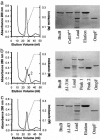Cell entry mechanism of enzymatic bacterial colicins: porin recruitment and the thermodynamics of receptor binding
- PMID: 16166265
- PMCID: PMC1236540
- DOI: 10.1073/pnas.0503567102
Cell entry mechanism of enzymatic bacterial colicins: porin recruitment and the thermodynamics of receptor binding
Abstract
Binding of enzymatic E colicins to the vitamin B12 receptor, BtuB, is the first stage in a cascade of events that culminate in the translocation of the cytotoxic nuclease into the Escherichia coli cytoplasm and release of its tightly bound immunity protein. A dogma of colicin biology is that the toxin coiled-coil connecting its functional domains must unfold or unfurl to span the periplasm, with recent reports claiming this reaction is initiated by receptor binding. We report isothermal titration calorimetry data of BtuB binding the endonuclease toxin ColE9 and a disulfide form (ColE9S-S) where unfolding of the coiled-coil is prevented and, as a consequence, the toxin is biologically inactive. Contrary to expectation, the thermodynamics of receptor binding, characterized by large negative values for TDeltaS, are identical for the two colicins, arguing against any form of BtuB-induced unfolding. We go on to delineate key features of the "colicin translocon" that assembles at the cell surface after BtuB binding by using a complex of histidine-tagged Im9 bound to ColE9S-S. First, we show that the porin OmpF is recruited directly to the BtuB.colicin complex to form the translocon. Second, recruitment is through the natively unfolded region of the colicin translocation domain, with this domain likely having two contact points for OmpF. Finally, the immunity protein is not released during its assembly. Our study demonstrates that although colicin unfolding is undoubtedly a prerequisite for E. coli cell death, it must occur after assembly of the translocon.
Figures




Similar articles
-
Primary events in the colicin translocon: FRET analysis of colicin unfolding initiated by binding to BtuB and OmpF.Biochemistry. 2008 Dec 2;47(48):12802-9. doi: 10.1021/bi800865h. Biochemistry. 2008. PMID: 18986168
-
The structure of BtuB with bound colicin E3 R-domain implies a translocon.Nat Struct Biol. 2003 Nov;10(11):948-54. doi: 10.1038/nsb997. Epub 2003 Oct 5. Nat Struct Biol. 2003. PMID: 14528295
-
Investigating early events in receptor binding and translocation of colicin E9 using synchronized cell killing and proteolytic cleavage.J Bacteriol. 2008 Jun;190(12):4342-50. doi: 10.1128/JB.00047-08. Epub 2008 Apr 11. J Bacteriol. 2008. PMID: 18408035 Free PMC article.
-
On mechanisms of colicin import: the outer membrane quandary.Biochem J. 2018 Dec 12;475(23):3903-3915. doi: 10.1042/BCJ20180477. Biochem J. 2018. PMID: 30541793 Review.
-
On the mechanism and pathway of colicin import across the E. Coli outer membrane.Front Biosci. 2004 May 1;9:1311-7. doi: 10.2741/1334. Front Biosci. 2004. PMID: 14977546 Review.
Cited by
-
Transmembrane Epitope Delivery by Passive Protein Threading through the Pores of the OmpF Porin Trimer.J Am Chem Soc. 2020 Jul 15;142(28):12157-12166. doi: 10.1021/jacs.0c02362. Epub 2020 Jul 2. J Am Chem Soc. 2020. PMID: 32614588 Free PMC article.
-
Colicin E1 opens its hinge to plug TolC.Elife. 2022 Feb 24;11:e73297. doi: 10.7554/eLife.73297. Elife. 2022. PMID: 35199644 Free PMC article.
-
Genome-wide screens: novel mechanisms in colicin import and cytotoxicity.Mol Microbiol. 2009 Aug;73(4):571-85. doi: 10.1111/j.1365-2958.2009.06788.x. Epub 2009 Jul 22. Mol Microbiol. 2009. PMID: 19650773 Free PMC article.
-
Swimming against the tide: progress and challenges in our understanding of colicin translocation.Nat Rev Microbiol. 2010 Dec;8(12):843-8. doi: 10.1038/nrmicro2454. Epub 2010 Nov 9. Nat Rev Microbiol. 2010. PMID: 21060316 Review.
-
Minimum length requirement of the flexible N-terminal translocation subdomain of colicin E3.J Bacteriol. 2007 Jan;189(2):363-8. doi: 10.1128/JB.01344-06. Epub 2006 Nov 3. J Bacteriol. 2007. PMID: 17085563 Free PMC article.
References
-
- Falnes, P. O. & Sandvig, K. (2000) Curr. Opin. Cell Biol. 12, 407–413. - PubMed
-
- James, R., Lazdunski, C. J. & Pattus, F. (1992) Bacteriocins, Microcins, and Lantibiotics (Springer, Heidelberg, Germany).
-
- Brook, I. (1999) Crit. Rev. Microbiol. 25, 155–172. - PubMed
-
- Kirkup, B. C. & Riley, M. A. (2004) Nature 428, 412–414. - PubMed
Publication types
MeSH terms
Substances
Grants and funding
LinkOut - more resources
Full Text Sources
Molecular Biology Databases

